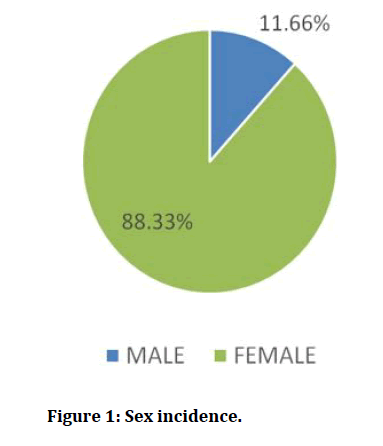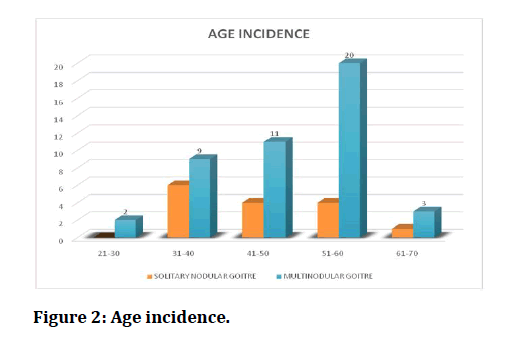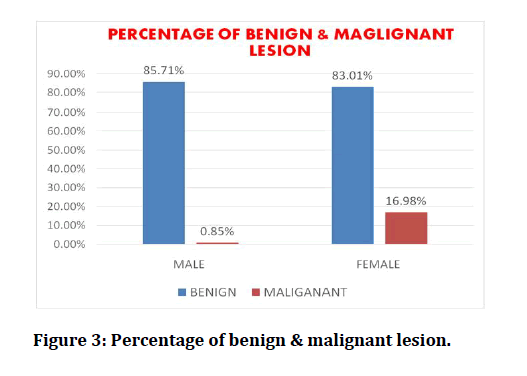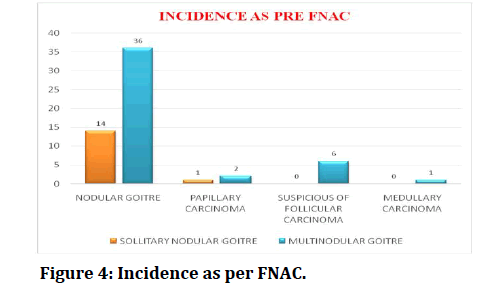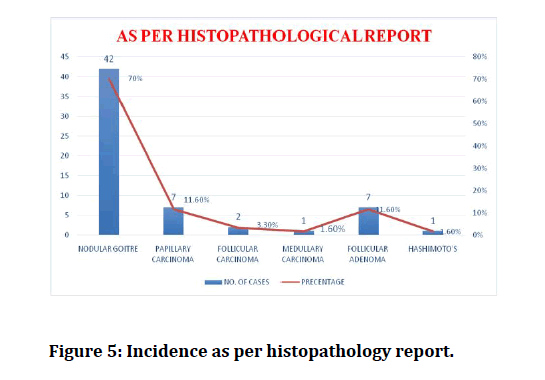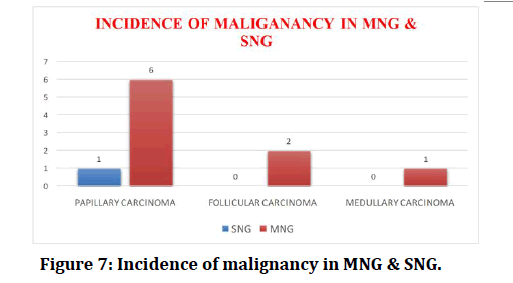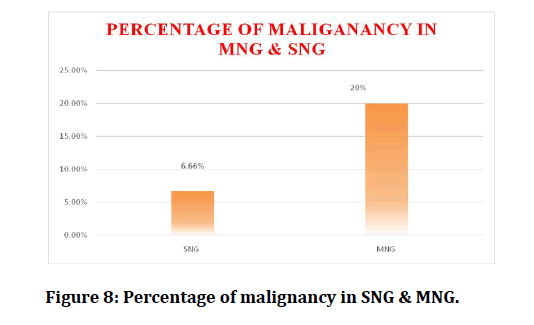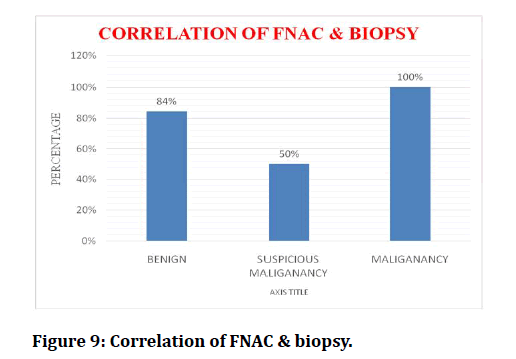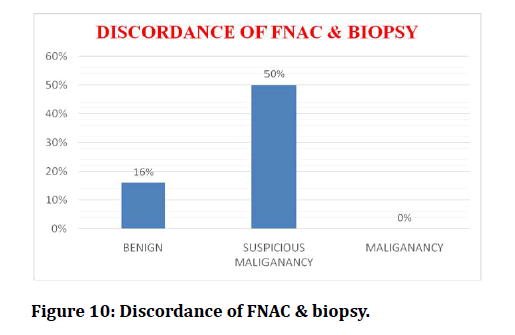Research - (2021) Volume 9, Issue 6
A Comparative Study of Fine Needle Aspiration Cytology with Histopathology of Thyroid Swelling
Naveen Kumar C, Varadaraju. P and Ravishankar KS*
*Correspondence: Ravishankar KS, Department of General Surgery, Sree Balaji Medical College & Hospital Affiliated to Bharath Institute of Higher Education and Research, Chennai, Tamil Nadu, India, Email:
Abstract
The thyroid gland arises as an out pouching of the primitive foregut around the third week of gestation. It originates at the base of the tongue at the foramen caecum. Endodermal cells in the floor of the pharyngeal anlarge thicken to form the medial thyroid enlarge. It descends from foramen caecum in front of pharynx as a bilobed diverticulum. By the end of 2nd month thyroid reaches its final position in front of trachea. The lower end of the diverticulum enlarges to form gland and the rest i.e., thyroglossal duct disappears. The purpose of this study was to observe the correlation of FNAC and histopathology in various thyroid swellings, Solitary nodular goiter, Multi nodular goiter, Suspected malignancy of thyroid, Malignancy of thyroid, to stress the importance of HPE as final diagnostic tool.
Keywords
Gestation, Thyroid gland, Diverticulum, Malignancy
Introduction
Thyroid gland is unique among endocrine organs. It is the largest endocrine gland in the body and the first to develop in fetal life. A thyroid nodule is either palpable clinically or ultrasound detected. Prevalence ranges from 4% to 10% in general adult and 0.2 to 1.5% in children. Nodular goitres are more common in women because of the presence of oestrogen receptors in thyroid issue. Most of the nodules are benign and only 5 to 10% of these nodules are malignant.
A multitude of diagnostic tests like ultrasound, thyroid nuclear scan, fine needle aspiration cytology (FNAC) and many more are available to evaluate a thyroid swelling. Final diagnosis requires morphological examination of lesions for which FNAC, and histopathological examination (HPE) becomes mandatory tests.
Fine needle aspiration cytology (FNAC) is now being accepted as the most cost-effective, minimal invasive technique with exceptionally low incidence of complications in the diagnosis of most of the thyroid lesions with an added advantage of segregating the patients of solitary thyroid nodule (STN) into operative and non-operative groups.
Still the histopathological examination of the thyroid gland was considered superior to FNAC in diagnosing the thyroid pathologies due to certain pitfalls in FNAC such as scanty sample, vascularity of thyroid swelling, variation in sampling technique and skill of the performing expert and as well as the experience of pathologist interpreting the aspirate. This study involves comparison of the diagnostic efficacy between FNAC and histopathology in our study population [1-19].
Materials and Methods
These studies include the patients who were operated for solitary and multinodular thyroid disease, suspicious malignant disease, and malignant disease. All cases were studied in detail with detailed clinical examination and investigations. Cases with hard thyroid swelling, male sex, fixity to surrounding structures, nerve involvement and cold nodules are studied in detail to rule out malignancy. Cases with cystic swellings are not aspirated they were subjected to surgery to rule out papillary carcinoma.
Procedure
Initial examination should be with patient in upright position, but FNAC done in supine position. Place a pillow under the neck. Ask the patient to keep still and to refrain from swallowing. Perform 2 to 4 aspiration in same session. Depending on the size of the thyroid swelling use different angles and change in point of entry. Cells are placed and prelabelled in dry glass slides. Some are immediately placed in 70% alcohol while others are air dried. The stain used is papanicolaou or Wright's stain. Skilled pathologist can accurately diagnose thyroid lesions.
Group I-Benign
All patients whose clinical examination showed features of solitary or multinodular thyroid disease with preoperative FNAC as nodule, colloid, adenomatous goitre.
Group II - Suspicious malignancy
Solitary nodular or multinodular goitre with preoperative FNAC showing suspicious of malignancy/ suspicious of follicular neoplasm.
Group III –Malignancy
Hard swelling, Pre-operative FNAC showing malignancy, H/o recent voice change, H/o difficulty in breathing or swallowing, Fixity to surrounding structures. Lymph node enlargement (secondary from thyroid nodule).
All 60 patients underwent surgery.
Final histopathology report obtained for all patients.
Results
In our study out of 60 patients 7 were male and 53 were female patients. Solitary thyroid Nodule observed in 15 cases (Male 1-Female 14) Multinodular goitre observed in 45 cases (Male -6, Female- 39) (Table 1 and Figure 1).
Figure 1: Sex incidence.
Table 1: Sex incidence.
| Sex | Solitary nodular goiter | Multinodular goitre |
|---|---|---|
| Female | 14 | 39 |
| Male | 1 | 6 |
Nodular thyroid disease occurred in age group of 20 to 70yrs. Youngest patient 27 yrs. oldest patient 67 yrs.
(Table 2 and Figure 2). Further results are illustrated in Tables (Table 3 to Table 9) and Figures (Figure 3 to Figure 8).
Figure 2: Age incidence.
Figure 3: Percentage of benign & malignant lesion.
Figure 4: Incidence as per FNAC.
Figure 5: Incidence as per histopathology report.
Figure 6: Diagnosis in FNAC & histopathology.
Figure 7: Incidence of malignancy in MNG & SNG.
Figure 8: Percentage of malignancy in SNG & MNG.
Table 2: Age incidence.
| Age Limit | Solitary nodular Goitre | Multinodular Goitre |
|---|---|---|
| 21-30 | 0 | 2 |
| 31-40 | 6 | 9 |
| 41-50 | 4 | 11 |
| 51-60 | 4 | 20 |
| 61-70 | 1 | 3 |
Table 3: Incidence as per FNAC.
| Diagonsis–cytological | No. Of cases |
|---|---|
| Nodular colloid goitre | 50 |
| Papillary carcinoma | 3 |
| Suspicious of follicular | 6 |
| Carcinoma | |
| Medullary carcinoma | 1 |
Table 4: Incidence & percentage in SNG & MNG as per FNAC.
| Diagnosis | Solitary Nodular Goitre | Multinodular Goitre | Percentage |
|---|---|---|---|
| Nodular | 14 | 36 | 83.33% |
| Colloid goitre | |||
| Papillary | 1 | 2 | 5% |
| Carcinoma | |||
| Suspicious of | - | 6 | 10% |
| Follicular carcinoma | |||
| Medullary Carcinoma | - | 1 | 1.66% |
Table 5: Incidence as per histopathology report.
| Diagonsis-Histopathological | No. Of Cases | Percentage |
|---|---|---|
| Nodular colloid Goitre | 42 | 70% |
| Papillary carcinoma | 7 | 11.60% |
| Follicular carcinoma | 2 | 3.30% |
| Medullary carcinoma | 1 | 1.60% |
| Follicular adenoma | 7 | 11.60% |
| Hashimotos Thyroiditis | 1 | 1.60% |
Table 6: Incidence in male & female as per histopathology.
| Diagonsis | Female | Male |
|---|---|---|
| Nodular colloid Goitre | 36 | 6 |
| Papillary carcinoma | 6 | 1 |
| Follicular carcinoma | 2 | - |
| Medullary carcinoma | 1 | - |
| Follicular adenoma | 7 | - |
| Hashimotos thyroiditis | 1 | - |
Table 7: Diagnosis of thyroid swelling in FNAC & histopathology.
| Diagnosis | FNAC | Histopathology |
|---|---|---|
| Nodular colloid Goitre | 50 | 42 |
| Papillary carcinoma | 3 | 7 |
| Suspicious of | 6 | - |
| Malignancy | ||
| Follicular | - | 2 |
| Carcinoma | ||
| Medullary | 1 | 1 |
| Carcinoma | ||
| Follicular adenoma | - | 7 |
| Hashimotos Thyroiditis | - | 1 |
Table 8: Incidence of Malignancy In SNG & MNG.
| Type of malignancy | Solitary nodular Goitre | Multinodular goitre |
|---|---|---|
| Papillary Carcinoma | 1 | 6 |
| Follicular Carcinoma | 0 | 2 |
| Medullary Carcinoma | 0 | 1 |
Table 9: Percentage of malignancy in SNG & MNG.
| Solitary nodular Goitre | Multinodular goitre | |
|---|---|---|
| Percentage of Malignancy | 6.66% | 20% |
Group I – Benign
- Number of benign disorders diagnosed by pre-operative FNAC=50.
- Correlated with HPE=42.
- Percentage of correlation=84%.
- Discordance in biopsy =8.
- Percentage of discordance=16%.
Group II-Suspicious of malignancy
- Number of Pre-operative FNAC diagnosed as suspicious of malignancy=6.
- Correlated with Biopsy=3.
- Percentage of correlation=50%.
- Discordance in Biopsy=3.
- Percentage of discordance=50%.
Group III-Malignant
- Number of Pre-operative FNAC diagnosed as malignant=4.
- Correlated with Biopsy=4 cases.
- Percentage of correlation–100%.
- Percentage of discordance–0% (Figure 9 and Figure 10).
Figure 9: Correlation of FNAC & biopsy.
Figure 10: Discordance of FNAC & biopsy.
Discussion
FNAC is easy to perform and safe with minimum complication rate. Care must be taken to obtain an adequate specimen-most authors recommend between 3 to 6 aspirations is needed. Satisfactory specimen contains at least 6 groups of 10 to 15 well preserved cells. They are categorized by their appearance to benign, indeterminate, or suspicious and malignant.
The diagnosis of papillary thyroid carcinoma by FNAC based on characteristic nuclear changes is reliable and accurate with sensitivity and specificity both approaching 100%.
In our study among 60 cases, 3 cases are reported as papillary carcinoma in FNAC. But after HPE report 7 cases are diagnosed as papillary carcinoma. So the discrepancy of 4 cases, the FNAC diagnosis of 4 cases were one as suspected follicular carcinoma and 3 cases were nodular colloid goitre type. In case of follicular neoplasm, the sensitivity of FNAC is about 90% and specificity less than 50% this limits the usefulness of FNAC. Tpo immuno chemistry with monoclonal antibody (MO Ab 47) improves the accuracy of FNAC for follicular lesions. It increases sensitivity to 100%specificity to 70%. Mundasad et al. [15] conducted a study on Accuracy of FNAC in diagnosis of thyroid swellings. In their study among 144 patients - FNAC revealed 94% benign, 6% malignant 4% suspicions. 13% inadequate, 4% indeterminate. But histopathology showed 82% benign, 18% malignancy. In their study the inadequate sample rate was 13%. The most important factors include experience of the aspirator and criteria used to define a satisfactory sample. Published dates suggest inadequate sample ranges between 9 to 31% in their study false negative rate is 23% i.e., FNAC negative for cancer but histology positive for cancer.
As per AACE /AME task force on thyroid nodules Endocr pract 2006:124 63 -102 the average false negative rate is 5% their guidelines to minimize false negative results are [9].
Oliver H beechars et al stated that goitres were frequently seen in women however, the incidence of carcinoma in man is greater than in women. In our study among 60 cases, the incidence of carcinoma in Male (1.6%) is greater than in female (15%). This is in accordance with various published reports. Fenn A.S et al1976 found that there was no great sex predominance in the incidence of malignancy [20].
According to Dr. C. Surya Prakash Rao et al. adenoma thyroid was the commonest benign lesion and papillary carcinoma was the commonest malignant lesion. Prof. R.L Gupta Delhi analyses 370 cases of solitary nodule. In his study, about 38 .7%. OF HPE report was different from FNAC. His study showed the fact that FNAC is not full proof and surgery with HPE report remain the only method of confirmation [21].
As Per Hossein gharib and papini et al. [8] nodule size is not predictive of malignancy. They have reported the following features are associated with increased risk of malignancy in thyroid nodule.
They concluded that risk of cancer is not significantly higher for solitary nodular than for glands with multiple nodules. But in our study the incidence of carcinoma in solitary nodular goitre (6.66 %) is more than multinodular goitre (20%).
According to koh and cole WH et al, the incidence of carcinoma in MNG Varies from 7% to 17% [14]. In our study the incidence of carcinoma in MNG is 20%.
Pier paolo gandolfi, et al [13] Italy conducted retrospective study among 58 cases who were operated for MNG. In their study, the incidence of carcinoma is 13.7%. They have stated that risk of malignancy should not be underestimated and a dominate nodule in MNG should be valued as it were a single nodule in an otherwise normal gland.
Raghuveer pedamullu, et al. conducted a retrospective study of 98 cases of MNG who underwent total thyroidectomy at Guntur government general hospital (India) from 2001 to 2004 he found the prevalence of MNG in female 88% in males 12% and incidence of female 88%. He concluded that despite negative FNAC the patients can still harbor a malignant focus due to high sampling error with MNG [12]. In our study FNAC showed 50 cases of nodular colloid goitre but histopathology showed on ly 42 nodular colloid goitre cases, the 8 cases turned out to be, papillary carcinoma in 3 cases, follicular adenoma in 4 cases, hashimoto’s thyroiditis in one case.
E Ghosal B Paul et al, analysed 75 patients with solitary nodule accurate correlation of FNAC HPE and report was possible only in 55 cases [22]. In our study among 15 solitary nodular goitres FNAC and HPE report correlation was possible only in 13 cases.
In a study done by Safirullah et al. it was reported the accuracy of FNAC as 94.2%, and another study done by Mundasad et al. and Gupta et al. the accuracy was 80% and 85% respectively [23-31]. In our study the accuracy of FNAC in detection of the thyroid swelling was found to be 80%.
Conclusion
In our study the commonest thyroid disease affecting study population are solitary nodular goitre, multinodular goitre, hashimoto’s, papillary carcinoma thyroid. Incidence of carcinoma in solitary nodular goitre 6.66%.
FNAC is simple, safe, and cost effective but HPE remains final diagnostic tool. Because FNAC cannot differentiate between adenoma and carcinoma in follicular and hurtle cell lesions. The suspicious results in FNAC prove to be an area of uncertainty often resolved by diagnostic surgical resection. In case of Multinodular goitre even if the preoperative FNAC is negative it does not exclude with certainty the possibility of a carcinoma because the error in sampling the right area is greater. Such evaluation may lead to non-radical operation and the need of a second surgery or radio therapy.
Funding
No funding sources.
Ethical Approval
The study was approved by the Institutional Ethics Committee.
Conflict of Interest
The authors declare no conflict of interest.
Acknowledgements
The encouragement and support from Bharath University, Chennai is gratefully acknowledged. For provided the laboratory facilities to carry out the research work.
References
- https://www.routledge.com/Bailey--Loves-Short-Practice-of-Surgery-27th-Edition/Williams-OConnell-McCaskie/p/book/9781498796507
- http://med-mu.com/wp-content/uploads/2018/07/Schwartzs-Principles-of-Surgery-10th-Ed-PDF-No-Watermarktahir99-VRG.pdf
- https://www.us.elsevierhealth.com/sabiston-textbook-of-surgery-9780323299879.html
- https://www.elsevier.com/books/robbins-and-cotran-review-of-pathology/klatt/978-1-4557-5155-6
- https://uotechnology.edu.iq/dep/bme/english/Pages/Lectures/anatomy%20first%20course/Grant's%20Atlas%20of%20Anatomy.pdf
- https://www.worldcat.org/title/fischers-mastery-of-surgery/oclc/809260929
- Oertel YC. Fine-needle aspiration of the thyroid: technique and terminology. Endocrinol Metabolism Clin North Am 2007; 36:737-51.
- Gharib H, Papini E. Thyroid nodules: clinical importance, assessment, and treatment. Endocrinol Metabol Clin North Am 2007; 36:707-35.
- AACE/AME. Task force on thyroid nodules American association of clinical endocrinologists and association Medici endocrinology medical guidelines for clinical practice for the diagnosis and management of thyroid nodules: Endocr Pract 2006; 12:63-102.
- Welker MJ, Orlov D. Thyroid nodules. Am Family Physician 2003; 67:559-66.
- Feld S. AACE clinical practice guidelines for the diagnosis and management of thyroid nodules. American Association of Clinical Endocrinologists; 1999.
- Raghiveer pedamallu, Pedamallu SB, Rama Rao K. Pedamallu incidence of occult cancer in MNG using HPE findings internet. J Surg 2008; 17.
- https://1library.net/document/4yrk6doz-comparison-fine-needle-aspiration-cytology-histopathology-thyroid-disease.html
- Koh KB, Chang KW. Carcinoma in multinodular goitre. J Br Surg 1992; 79:266-7.
- Mundasad B, Mcallister I, Pyper P, et al. Accuracy of fine needle aspiration cytology in diagnosis of thyroid swellings. Cytopathology Supplement 2003; 14.
- Caraway NP, Sneige N, Samaan NA. Diagnostic pitfalls in thyroid fineâ?needle aspiration: A review of 394 cases. Diagnostic Cytopathol 1993; 9:345-50.
- https://journals.lww.com/intjgynpathology/Fulltext/2006/07000/Fine_Needle_Aspiration_Cytology,_4th_Edition.19.aspx
- Psarras A, Papadopoulos SN, Livadas D, et al. The single thyroid nodule. J Br Surg 1972; 59:545-548.
- Kopald KH, Layfield LJ, Mohrmann R, et al. Clarifying the role of fine-needle aspiration cytologic evaluation and frozen section examination in the operative management of thyroid cancer. Archives Surg 1989; 124:1201-5.
- Fenn AS, Krishnan KV, Devadatta J, et al. Solitary nodules of thyroid gland review of 342 cases. Indian J Surg 1980; 40:175-7.
- Suryaprakash Rao, Ramaskrishna DV. An analysis of 100 cases of thyroid desease–ASI Conference 1990.
- Ghosal B, Paul NC, Majundas PM. FNAC in diagnosis ofthyroid nodules correlation with HPE report and application in thyroid surgery. Indian J Surg 1984; 16:76 -83.
- Balakrishnan R. A follow up study by fine needle aspiration cytology in solitary nodular goitre in GVMCH (Doctoral dissertation, Government Vellore Medical College, Vellore).
- Johnson CD, Taylor I. Recent Advances in surgery. 13-159-173.
- Agarwal S. Diagnostic accuracy and role of fine needle aspiration cytology in management of thyroid nodules. J Surg Oncol 1995; 58:168-172.
- Rojeski MT, Gharib H. Nodular thyroid disease. Evaluation and management. New Eng J Med 1985; 313:428-436.
- Asotra S, Sharma J. Role of AgNORs in thyroid lesions on FNAC smears. J Cytol 2008; 25:18-22.
- Layfield LJ, Cibas ES, Gharib H, et al. Thyroid aspiration cytology: Current status. Cancer J Clin 2009; 59:99-110.
- Guhamallick M, Sengupta S, Bhattacharya NK, et al. Cytodiagnosis of thyroid lesions-usefulness and pitfalls: A study of 288 cases. J Cytol 2008; 25:6-9.
- Mundasad B, Callisier I, Carson Pyper P. Accuracy of fine needle aspiration cytology in the diagnosis of thyroid swelling. Int J Endocrinol 2006; 2:20-25.
- Saleh AF, AJ NR, Salam MA, et al. Role of fine needle aspiration cytology (FNAC) in the diagnosis of prostatic lesions with histologic correlation. Bangladesh Med Res Council Bulletin 2005; 31:95-103.
Author Info
Naveen Kumar C, Varadaraju. P and Ravishankar KS*
Department of General Surgery, Sree Balaji Medical College & Hospital Affiliated to Bharath Institute of Higher Education and Research, Chennai, Tamil Nadu, IndiaCitation: Naveen Kumar C, Varadaraju. P, Ravishankar KS, A Comparative Study of Fine Needle Aspiration Cytology with Histopathology of Thyroid Swelling, J Res Med Dent Sci, 2021, 9(6): 62-69
Received: 25-Mar-2021 Accepted: 11-Jun-2021 Published: 18-Jun-2021

